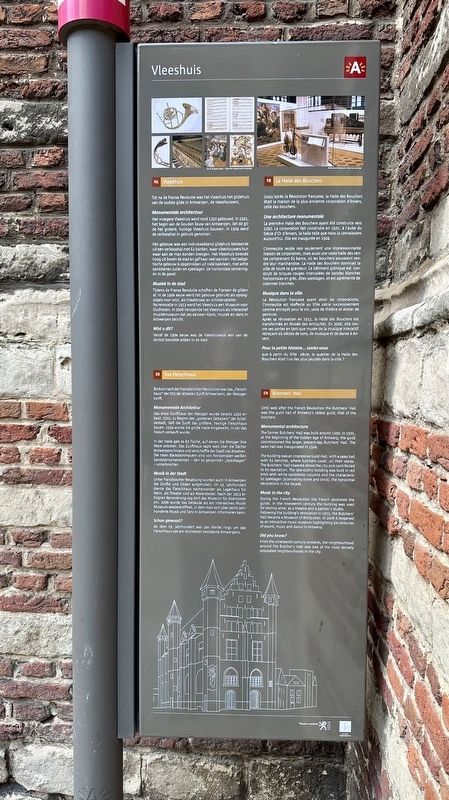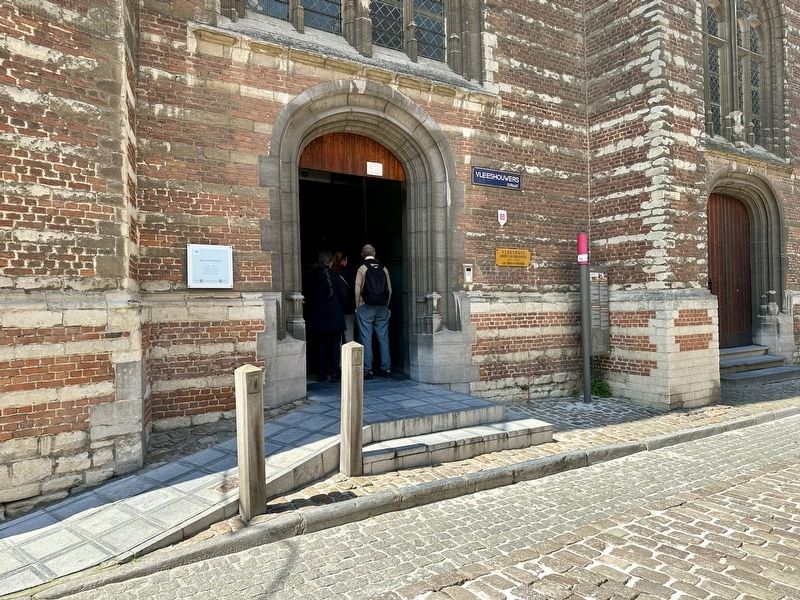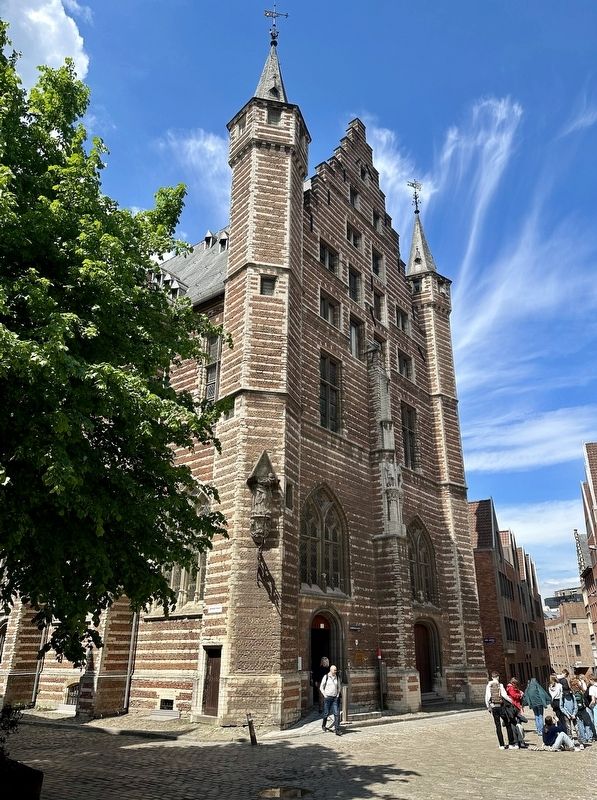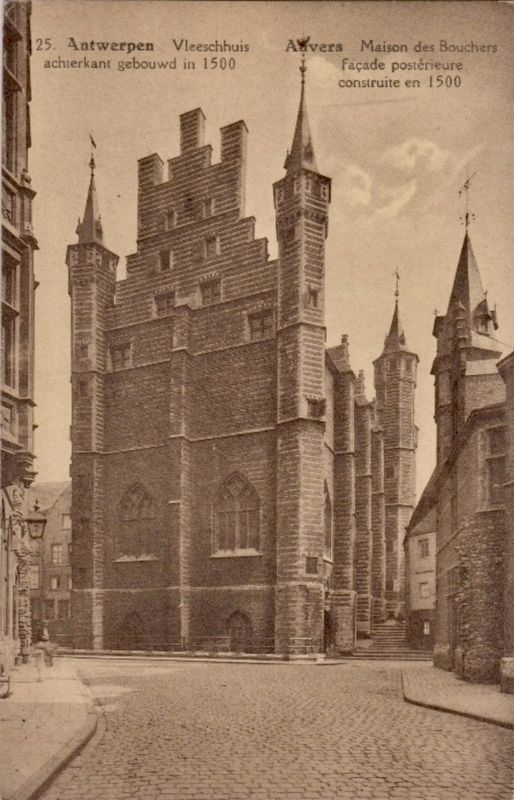Historisch centrum in Antwerpen, Flanders, Belgium — Northwestern Europe
Vleeshuis / Das Fleischhaus / La Halle des Bouchers / Butchers’ Hall
Inscription.
Vleeshuis
Tot na de Franse Revolutie was het Vleeshuis het gildehuis van de oudste gilde in Antwerpen, de vleeshouwers.
Monumentale architectuur
Het vroegere Vleeshuis werd rond 1250 gebouwd. In 1501, het begin van de Gouden Eeuw van Antwerpen, liet de gilde het grotere, huidige Vleeshuis bouwen. In 1504 werd de verkoophal in gebruik genomen.
Het gebouw was een indrukwekkend gildehuis bestaande uit een verkoophal met 62 banken, waar vleeshouwers hun waar aan de man konden brengen. Het Vleeshuis torende hoog uit boven de stad en gaf haar veel aanzien. Het laatgotische gebouw is opgetrokken uit rode baksteen, met witte zandstenen zuilen en speklagen: de horizontale versieringen in de gevel.
Muziek in de stad
Tijdens de Franse Revolutie schaften de Fransen de gilden af. In de 19de eeuw werd het gebouw gebruikt als opslagplaats voor wijn, als theaterzaal en schildersatelier. Na renovatie in 1913 werd het Vleeshuis een Museum voor Oudheden. In 2006 heropende het Vleeshuis als interactief muziekmuseum dat zes eeuwen klank, muziek en dans in Antwerpen belicht.
Wist u dit?
Vanaf de 19de eeuw was de Vleeshuiswijk een van de dichtst bevolkte wijken in de stad.
Das Fleischhaus
Bis kurz nach der Französischen Revolution war das Fleischhaus der Sitz der ältesten Zunft Antwerpens, der Metzger zunft.
Monumentale Architektur
Das erste Zunfthaus der Metzger wurde bereits 1250 erbaut. 1501, zu Beginn des „goldenen Zeitalters" der Scheldestadt, ließ die Zunft das größere, heutige Fleischhaus bauen. 1504 wurde die große Halle eingeweiht, in der das Fleisch verkauft wurde.
In der Halle gab es 63 Tische, auf denen die Metzger ihre Ware anboten. Das Zunfthaus ragte weit über die Dächer Antwerpens hinaus und verschaffte der Stadt viel Ansehen. Die roten Backsteinmauern sind von horizontalen weißen Sandsteinornamenten- den so genannten „Specklagen“ - unterbrochen.
Musik In der Stadt
Unter französischer Besatzung wurden auch in Antwerpen die Zünfte und Gilden aufgehoben. Im 19. Jahrhundert diente das Fleischhaus nacheinander als Lagerhaus für Wein, als Theater und als Maleratelier. Nach der 1913 erfolgten Renovierung zog dort das Museum für Altertümer ein. 2006 wurde das Gebäude als ein interaktives Musik Museum wiedereröffnet, in dem man sich über sechs Jahr hunderte Musik und Tanz in Antwerpen informieren kann.
Schon gewusst?
Ab dem 19. Jahrhundert war das Viertel rings um das Fleischhaus das am dichtesten bevölkerte Antwerpens.
La Halle des Bouchers
Jusqu'après la Révolution française, la Halle des Bouchers était la maison de la plus ancienne corporation d'Anvers, celle des bouchers.
Une architecture monumentale
La première Halle des Bouchers ayant été construite vers 1250. La corporation fait construire en 1501, à l'aube du Siècle d'Or d'Anvers, la halle telle que nous la connaissons aujourd'hui. Elle est inaugurée en 1504.
L'immeuble recèle non seulement une impressionnante maison de corporation, mais aussi une vaste halle des ventes comprenant 62 bancs, où les bouchers pouvaient vendre leur marchandise. La Halle des Bouchers dominait la ville de toute sa grandeur. Ce bâtiment gothique est construit de briques rouges intercalées de bandes blanches horizontales en grès, dites speklagen, et est agrémenté de colonnes blanches.
Musique dans la ville
La Révolution française ayant aboli les corporations, l'immeuble est réaffecté au XIXe siècle successivement comme entrepôt pour le vin, salle de théâtre et atelier de peinture. Après sa rénovation en 1913, la Halle des Bouchers est transformée en Musée des Antiquités. En 2006, elle rouvre ses portes en tant que musée de la musique interactif retraçant six siècles de sons, de musique
et de danse à Anvers.
Pour la petite histoire... saviez-vous
que à partir du XIXe siècle, le quartier de la Halle des Bouchers était l'un des plus peuplés dans la ville?
Butchers' Hall
Until well after the French Revolution the Butchers' Hall was the guild hall of Antwerp's oldest guild, that of the butchers.
Monumental architecture
The former Butchers' Hall was built around 1250. In 1501, at the beginning of the Golden Age of Antwerp, the guild commissioned the larger, present-day Butchers' Hall. The sales hall was inaugurated in 1504.
The building was an impressive Guild Hall, with a sales hall with 62 benches, where butchers could sell their wares. The Butchers' Hall towered above the city and contributed to its reputation. The late-Gothic building was built in red brick with white sandstone columns and the characteristic speklagen (alternating stone and brick), the horizontal decorations in the facade.
Music in the city
During the French Revolution the French abolished the guilds. In the nineteenth century the building was used for storing wine, as a theatre and a painter's studio. Following the building's renovation in 1913, the Butchers Hall became a Museum of Antiquities. In 2006 it reopened as an interactive music museum highlighting six centuries of sound, music and dance in Antwerp.
Did you know?
From the nineteenth century onwards, the neighbourhood around the Butcher's Hall was one of the most densely populated neighbourhoods in the city.
Topics. This historical marker is listed in these topic lists: Architecture • Arts, Letters, Music • Industry & Commerce • Labor Unions. A significant historical year for this entry is 1250.
Location. 51° 13.356′ N, 4° 23.973′ E. Marker is in Antwerpen, Vlaams Gewest (Flanders). It is in Historisch centrum. Marker is on Vleeshouwersstraat. Touch for map. Marker is at or near this postal address: Vleeshouwersstraat 10, Antwerpen, Vlaams Gewest 2000, Belgium. Touch for directions.
Other nearby markers. At least 8 other markers are within walking distance of this marker. Het Steen (about 150 meters away, measured in a direct line); Ruihuis (about 180 meters away); Antoon van Dijck (about 210 meters away); Ernest van Dyck (approx. 0.2 kilometers away); Snoepje Napoleon / Napoleon Candy (approx. 0.3 kilometers away); Sint-Annagodshuis / Saint Anne Almshouse (approx. 0.4 kilometers away); Sint-Carolus Borromeuskerk / St. Charles Borromeo Church (approx. 0.4 kilometers away); Albrecht Duerer (1471-1528) (approx. 0.4 kilometers away). Touch for a list and map of all markers in Antwerpen.
Credits. This page was last revised on February 22, 2024. It was originally submitted on February 22, 2024, by Andrew Ruppenstein of Lamorinda, California. This page has been viewed 44 times since then. Photos: 1, 2, 3, 4. submitted on February 22, 2024, by Andrew Ruppenstein of Lamorinda, California.



